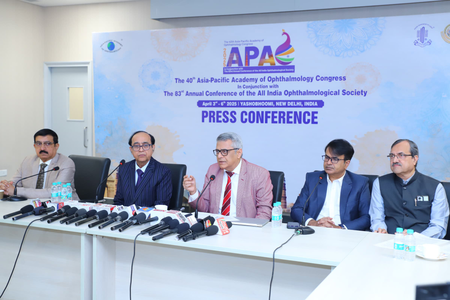Leading ophthalmologists have raised concerns over an alarming rise in cases of dry eye syndrome, myopia progression, eye strain, and early-onset squinting among children and young adults who spend excessive hours watching reels on social media platforms. This emerging crisis, termed “Reel-Induced Eye Damage,” has been linked to prolonged exposure to high-speed, visually stimulating content on popular platforms like Instagram, TikTok, Facebook, and YouTube.
Speaking at a joint meeting of the Asia Pacific Academy of Ophthalmology and the All India Ophthalmological Society in New Delhi, healthcare experts highlighted the mounting toll of digital screen consumption on ocular health across all age groups. A growing number of children, students, and professionals are reportedly struggling with digital eye strain and worsening eyesight due to extended hours of screen fixation.
Doctors shared concerning anecdotes from their practice to illustrate the severity of the problem. For instance, a student who complained of persistent eye irritation and blurry vision was diagnosed with insufficient tear production after hours of watching reels at home. The child was promptly prescribed eye drops and advised to follow the “20-20-20 rule,” which involves taking a 20-second break every 20 minutes to look at an object 20 feet away.
Medical professionals are increasingly alarmed by the wider implications of constant reel consumption, including reduced blink rates and difficulty in shifting focus between near and distant objects, a condition known as accommodation spasms. The sustained fixation on short, engaging reels diminishes the natural blinking reflex by nearly 50 percent, leading to dry-eye syndrome and other related disorders.
The psychological and social toll of excessive screen time further compounds the problem. Experts report cases of social isolation, cognitive overload, and mental fatigue among individuals who spend long hours immersed in digital content. Children are particularly vulnerable, with many developing early myopia at rates faster than ever before, while adults often experience headaches, migraines, and sleep disorders linked to blue light exposure.
Healthcare experts warn that unchecked habits of prolonged reel-watching could lead to permanent vision problems. Ophthalmologists stressed the importance of preventive measures such as increasing blink rates and engaging in digital detoxes to minimize dependency on screens. Implementing simple practices, like the 20-20-20 rule, could significantly reduce the risk of long-term eye damage.
The far-reaching consequences of “Reel-Induced Eye Damage” are not limited to physical health alone. Doctors also note its impact on social relationships and productivity. According to observations shared during the event, many individuals are so absorbed in watching reels that they neglect real-world interactions, resulting in strained family dynamics and diminished focus on education or work responsibilities.
Senior ophthalmologists emphasized the urgency of addressing this growing public health challenge, advocating for increased awareness and proactive measures to combat the harmful effects of excessive digital screen use. They underscored the necessity of balancing screen time with real-world engagement and prioritizing ocular health to prevent long-term damage.
With the prevalence of short-form digital videos skyrocketing, experts caution that immediate action is needed to curb the adverse effects on vision, mental well-being, and social harmony. The call to mitigate “Reel-Induced Eye Damage” represents a crucial step in safeguarding the health and productivity of future generations.





